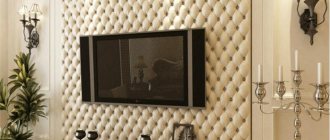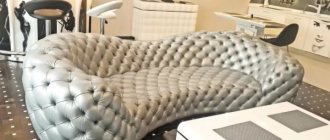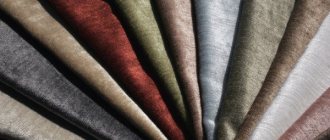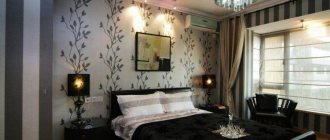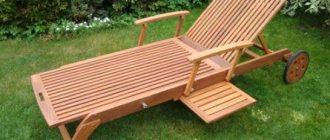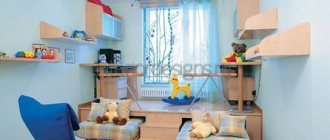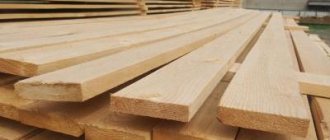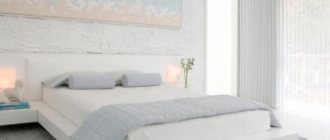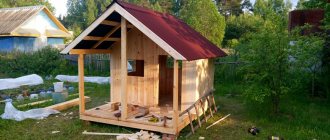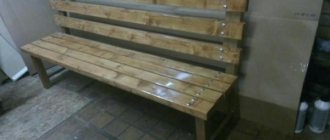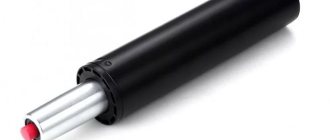The quality and decent appearance of any interior largely depend on correctly selected furniture. In addition to cabinets, sideboards, coffee tables, shelves and chests of drawers, the style of the room is determined by upholstered furniture, the quality of its finishing and covering material. In classic interiors, designers prefer to use quilted carriage screed, which came into fashion when equipping living spaces several centuries ago. However, factory-made such products are too expensive, and not every average person can afford them. In this regard, many home craftsmen purchase fabrics or leather and do the work of making and installing a carriage coupler with their own hands.
Carriage screed on the wall
What is a carriage tie?
Carriage screed is a special type of finishing of upholstered furniture in a classic style, the technology of which originated more than 300 years ago in Europe. Throughout the history of its use, right up to the present day, this type of interior design has been associated with vintage luxury and wealth. The technology got its name because initially the seats of carriages for aristocrats were upholstered in this way, after which the fashion for this type of finishing moved to the interiors of rich houses.
Carriage screed on furniture
Today, the carriage screed has lost mass popularity, but, at the same time, is in active demand among adherents of the classical style of decorating apartments, offices and private residential buildings. Over the course of a long time, the carriage screed, which also has a second name - “capitone”, has changed significantly, and designers offer many options for quilted covering for upholstered furniture, walls, decorative panels, high headboards and other interior items.
Carriage tie at the head of the bed
Pros and cons of cardboard screed
Why do many people prefer to make Capitone upholstery themselves rather than buy a ready-made product:
- you have a chance to make truly unique furniture that you will not see anywhere else;
- the design, color scheme and style will completely match your interior or fit perfectly into the design that you want to bring to life;
- there is no need to choose from limited options, because you purchase all the necessary materials yourself: fabric by color, texture, density, price;
- You will significantly save your budget by doing everything yourself.
Of course, before you start tightening the head of the bed with a carriage tie, you should carefully study the instructions and think through all the steps.
Advantages of carriage screed
The type of room decoration under consideration, combined with a classic interior, has many advantages over other techniques aimed at expressing the similar style of the room:
- Increased comfort during use - soft quilted upholstery in combination with high-quality leather, corduroy, velvet or thick fabric ensures comfortable seating for residents.
Leather product
- The surface is always in a taut state; new folds do not form on it during prolonged use. Sofas, panels and other interior elements are easy to clean wet or dry.
Material stretching
- When properly selected high-quality material, “capiton” has an increased service life. Thanks to the tension of the tie, jamming and friction of surface elements among themselves is eliminated, which guarantees their long-term safety, even during intensive use.
High-quality velvet screed
- Threads, buttons, braid and other finishing elements securely fix the material, giving it increased strength.
Buttons for the product
- When physical wear and tear is reached, when the coating needs to be replaced or restored, it is easily replaced with a new one, without the need to purchase filler or a new piece of furniture.
Capitone repair
- One of the main advantages of this technology is the possibility of widespread use on any type of surface. Experienced designers suggest using carriage screed not only on furniture and headboards, but also on parts of wall structures, columns, on vertical or horizontal panels and on many other interior details.
Carriage screed in the interior
- The carriage screed is one of the main elements of expressiveness of several eras in many countries. Vintage interiors, the English style of the 19th century, and even the Empire style of the first half of the 20th century are perfectly combined with the “Capitone” surface finishing technique. This style is the best way to add luxury and respectability to a room.
English style finishing
Empire style finishing
- If the carriage screed is installed on the wall, a porous filler made of natural or synthetic materials greatly increases the level of sound and heat insulation. It is advisable to use this decorative element when decorating the inner surface of walls bordering street space, as well as adjacent rooms belonging to other residents.
Filler
- When installing carriage screed on walls or ceilings, unlike classic painting, plastering or wallpapering, this type of finishing does not require leveling the supporting or enclosing structure. The soft elastic material levels out all unevenness, and on the finished surface of the fabric or leather, defects are completely masked.
Elastic surface
- This type of finishing device allows you to absorb sounds, which is especially important for large rooms with sparsely arranged furniture - in the absence of echo, comfort during its operation increases.
Soundproof barrier
- This type of finishing is a classic of the genre that will always remain relevant and will not go out of fashion. Adherents of the vintage style don’t have to worry about the fact that the decoration will have to be changed in a few years, as the interior design style of an apartment, office or private residential building is hopelessly outdated.
Carriage screed in a modern interior in a modern interior
Considering the degree of tension of the canvas, when installing a carriage screed, you should choose only high-quality material of increased strength. Thin fabrics or cheap leatherette can easily tear in the first months after the start of use.
Step-by-step instruction
Step-by-step instructions for making a carriage screed
So that you can make a carriage screed yourself, we suggest you consider the step-by-step instructions with photographs of this process. After familiarizing yourself with it, you can also watch an additional video on how to make capitonne using a different technology. All details can be seen in the table:
| Manufacturing instructions | |
| Plywood marking | The first thing to do after cutting out the plywood of the desired shape and size is to mark and make holes in it. |
| Applying glue to plywood | Then glue is applied to the plywood. |
| Gluing plywood | Foam rubber is glued. |
| Marking screed on foam rubber | The screed is marked on the foam rubber using a simple pencil. The marker may transfer to the fabric, causing the upholstery to lose its attractiveness. |
| Making holes | Then the holes are drilled using a drill with a Ziefendorf attachment. |
| Excess foam is removed | Excess foam rubber is removed. |
| A padding polyester is laid on top of the foam rubber. | A padding polyester is laid on top of the foam rubber. |
| Gluing padding polyester | The synthetic winterizer is glued with foam glue. |
| Markings on the skin | We make markings on fabric/leather. We retreat from the edge by the width to the first tightening + 7.5 cm for the allowance. |
| Stencil to help with marking | Next you need to take a stencil prepared in advance from cardboard with holes. It is applied to the wrong side of the fabric/leather. |
| Reconciliation of markings | The first marked point on the fabric/leather is checked. On all sides, the indentation of fabric/leather from the edge to the marks should be the same - the length from the edge to the first drawstring + 7.5 cm. |
| Putting the dots | Let's put points. |
| Insert threads | We insert threads into all marked tightening points. |
| Securing the first row | Now we pull the first row of threads using a needle or a special hook through the foam rubber and plywood and nail it to it with a stapler. |
| Formation of the second row | Then we turn the fabric/leather inside out and insert the next row of threads, lay out the folds and nail the threads with a stapler. If the template and markings are done correctly, then there will be enough fabric to create beautiful folds. To avoid skew and correctly lay the folds, you should lay them gradually, from row to row. |
| Straightening out wrinkles | It is convenient to straighten wrinkles using a special stick. After the row is completed, we proceed to the next one. |
| Fastening the ties from the middle | You should start securing a row of ties from the middle. In this case, the fabric will not stretch, and the finished capitonné upholstery will look very attractive. Before securing the thread with a stapler, you should carefully straighten the folds. |
| Product check | We check the product to ensure that all diagonals are even, straighten the folds if necessary. |
| Inserting and fixing buttons | We insert and fix several buttons. You can also insert buttons along the edges. But before the folds are fixed. |
| Formation of side folds | We form the side folds. |
| Fixing side folds | We fix the counter fold, which will result in a perfectly straight edge. |
| Fixing the corner | After all the extreme folds have been laid, the corner should be fixed. If you correctly calculate the material and fix the ties, there will be no difficulties at this stage. |
| Securing an edge | Ready corner. Final fastening of the edge. |
| Ready screed | The finished Capito screed made using this technology looks very attractive. It is worth noting that the process of its manufacture is not that complicated. What takes the most time is preparing materials and marking, while screeding is a fun and not so complicated process. |
Disadvantages of carriage screed
In addition to many advantages, professional designers and premises owners often note some disadvantages of carriage screed:
- A thick layer of lining material significantly reduces the internal volume of the room. Finishing like "capitonné" is appropriate in rooms with a large area and high ceilings.
Bulky furniture
- Carriage screed covering upholstered furniture or headboards visually enlarges the pieces of furniture. When it is used within standard apartments with small rooms, the comfort of the room is lost, due to the fact that the usable space of the room seems smaller than it actually is.
- If this type of finishing uses not leather or a high-quality polymer substitute with a glossy surface, but velvet fabric, then accidentally introduced oil, food waste or other contaminants leave a greasy mark on the surface, which is very difficult to remove.
Marks on the fabric surface
- If you choose cheap material, it is easily damaged by the paws of pets, or from rough mechanical impact when in contact with sharp objects.
Damage to the coating
- The complexity of finishing work and the increased price of high-quality materials compared to other types of design solutions for interior equipment.
The complexity of the screed device
All disadvantages are subjective and may not be taken into account. Properly selected colors, high-quality screeds combined with the overall style of a classic interior allow the owners to get an elegant interior and enjoy its use for many years.
Proper execution of decor
At the end of the carriage screed, all the holes made are found and marks are made with a pencil. Using a drill, shallow holes are made in these places. The diameter of the drill and hook must match to ensure smooth fastening.
Then a hook is inserted from the inside of the panel, and its edge is brought out. This procedure is performed in each hole, after which cords are attached to the hooks, and buttons are placed on their ends.
After this, the cords are pulled from the inside so that the buttons are pressed into the material with the same depth.
As holders on the back side of the panel, you can use special screws that are fixed into the wall.
How to choose the right fabric for a carriage tie
The quality, as well as the service life of the carriage screed, largely depend on the characteristics and composition of the material from which it is made. When choosing fabric for covering, it is necessary to take into account the following features and requirements:
- Regardless of the composition, it should be taken into account that when manufacturing this category, the material is subject to strong tension, which is why it must have increased thickness, density and strength. Regular cotton fabric, or thin polyester or silk are not suitable for carriage ties.
Thick fabric for covering
Thick genuine leather for covering
- When choosing the density of the material, it is also necessary to pay attention to the elasticity of the fibers. The fabric is tensioned not only during installation - it remains in this state throughout its entire service life. Thus, fabrics that easily stretch when a load is applied will eventually become unusable, and the coating that has lost its shape will have to be changed.
Elastic fabric
- When making a carriage screed, many folds form on the surface of the material. In this regard, if there is a pattern on the surface of the material, upon completion of the work, most of its surface will be hidden in these folds. This means that with this type of finishing only plain material is used. At the same time, the use of a periodic meaningless ornament covering the entire surface of the material is allowed, since it will successfully merge with the folds after finishing.
- Considering that the cost of the work is quite high, the material must also be from a higher price category, and its quality must justify this price. As a rule, when constructing carriage screeds, dense, high-quality natural leather or multi-layer compounds with a velvet or smooth surface are used. Modern designers trying to create fashionable interiors often recommend using thick denim fabric. This significantly improves the quality of the coating, increases its durability during intensive use, and also adds originality to the bold design solution.
If you choose fabric or leather of poor quality, all expensive finishing may become unusable and must be replaced after 1 to 3 years of use. Purchasing an expensive coating followed by high-quality installation while following the technology will allow the surface to be used for decades without the need for repairs.
Our offer
Brings to your attention custom-made upholstered furniture according to individual designs and sizes. The Capiton stitch technology is used in the manufacture of furniture. It is also possible to manufacture and install wall panels using the “Carriage Stitch” principle.
A catalog of ready-made sofas and armchairs can be viewed in the “Upholstered Furniture” section on our website. “Carriage stitch” combines the rigor of a geometric pattern and the flirtatiousness of the resulting puffs. Therefore, the unique technology is suitable for absolutely any interior style.
- This:
- Affordable prices;
- Wide range of models;
- The latest trends and advanced technologies.
Auxiliary materials for constructing a carriage coupler
To make a panel from a carriage screed, or to decorate any interior detail using this technology, in addition to fabric or leather, you will need a number of auxiliary materials, since the coating is a whole complex structure:
- Base - a sheet of plywood, OSB, board panel and other elements of increased strength can be used as a supporting material. The thickness of the sheet for the base must be at least 5 - 8 mm, and the material must have increased strength against impact. Also, there are additional requirements for the flexibility of the material, which depend on the overall dimensions of the product.
- Fabric or leather for upholstery, the selection criteria for which are described in detail above. Also, it should be added that the material has many folds, which is why the construction of a wall or panel requires much more of it - 30% - 40% than the total area of the future product.
Leather range
Assortment of fabrics
- The carriage screed implies a soft volumetric surface, which is why elastic material of the internal padding must be laid between the base and the finishing coating. As such a composition, a well-compressible synthetic material that is not susceptible to settlement over time should be used. As a rule, foam rubber, which is sold in rolls, is suitable for such purposes. The perception of the volumetric structure will depend on the thickness of the packing material, and therefore the minimum value of this parameter should not exceed 50 – 70 mm.
Foam rubber for stuffing
- Finishing this type of surface always involves making deep stitches using special furniture nails with wide heads or buttons. You should purchase only metal products, as they will not crack or fly off during use.
Furniture nails with wide heads
- To stitch the fabric and attach buttons to it, high-strength thick nylon threads are required that can withstand a force of at least 15 - 20 kg.
High-strength nylon threads
- Dressing leather or fabric using carriage screed technology requires preliminary preparation of templates, which must be cut out of soft plastic or thick cardboard.
Cardboard templates
- The padding material must be securely fixed to the base before performing this type of screed. In this regard, a special adhesive composition that does not contain high concentrations of toxic substances will be required.
Furniture adhesive composition
Depending on the method of finishing the edge, you will also need to purchase additional tape, metal or plastic corners, a wooden baguette or other framing material that allows you to implement the design project.
Materials and tools for upholstery panels
In order to make the surface upholstery in accordance with all requirements, it is necessary to prepare some materials and equipment for the work.
The materials you will need to purchase are:
- Plywood sheet, the thickness of which must be at least 7 millimeters. In this case, the exact parameters of the base depend on the preliminary drawing.
- Thick, one-color upholstery fabric. It should be borne in mind that the canvas must have a size one and a half times larger than the base itself - this is necessary to form the relief.
- Dense furniture foam rubber with a thickness of at least 5 centimeters exactly to the size of the base. If necessary, it can be replaced with padding polyester of similar thickness.
- Buttons for fixing with a diameter of about 2 centimeters. Their number will depend on the dimensions of the facing panel and the characteristics of the ornament.
- Thick threads for securing buttons.
- Cardboard for making patterns.
- Glue for joining foam rubber and plywood base.
In addition, during the work you will need the following devices:
- metal rulers of different lengths;
- measuring tape;
- markers for textiles;
- a screwdriver with a special cutting attachment;
- jigsaw;
- furniture stapler.
Special attention should be paid to the special attachment for rounded cutouts - it is called a tsifenbor. It is fixed to an electric drill or screwdriver, after which it will be possible to cut indentations on the surface. The peculiarity is that in this way not only foam rubber is cut, but also denser types of material, even wood.
Special nozzle for cutting foam rubber
Tools for installing a carriage coupler
Carriage screeding is considered a complex production process, which requires not only high-quality material or extensive experience of the craftsman, but also a set of special tools and other equipment:
- First of all, before cutting and starting work, it is necessary to take measurements. This procedure is carried out using plastic, wooden or metal rulers with a length of 1000 mm or more. Such measuring instruments are often used in many professional studios.
Long ruler for textiles
- To accurately measure flexible material around a circle or any other curved surface, you will also need a flexible measuring tool made from fabric or polymer material.
Flexible measuring tool
- To mark the wrong side of the fabric before cutting or stitching, specialized fabric markers are used. These tools are clearly visible on any textile surface, but at the same time, when applied, the material does not get wet.
Textile markers
- To tighten and make holes, it is necessary to create a torque, which is achieved using a special device - a screwdriver.
Screwdriver
- To cut the product after applying a load, you need to purchase a bit with a built-in blade.
Cutter for screwdriver
- Punctures in fabric or leather are made using an awl.
Awl
- Bit attachment for a screwdriver or drill with a crown, for making round cuts in soft material.
Drill bit
- The cutting of the base in the form of plywood or chipboard sheet is carried out using a circular saw or an electric jigsaw with a replaceable cutting blade.
Hand circular saw
Jigsaw
- To secure fabric or leather to the base from the wrong side, after tensioning and stuffing, a furniture stapler with reinforced staples is used, which can easily pierce plywood.
Furniture stapler
Staples for furniture stapler
All tools used when making carriage screeds must be of high quality and in good working order, and the cutting edges must be well sharpened. Otherwise, good quality work will not be achieved.
How to prepare the base for a headboard
Before making holes in a sheet of foam rubber, markings should be made.
Take a marker and a long ruler and draw out a diagram of the carriage tie. It’s even easier to cut out a regular rhombus or square from plain paper in advance, and then use it to mark a sheet of foam rubber. At the very beginning, apply two guides - vertical and horizontal stripes. And then place the template with the center at the point of intersection of the axes, and then draw sequentially.
The top marks of the diamonds are where the buttons are attached. This is where you need to make even holes in the foam using a drill. If you don’t have a drill on the farm, you can use a piece of metal pipe, but you will have to work hard to cut through the foam rubber. You can even try to make holes with a stationery knife; during screeding, flaws and unevenness on the furniture will be hidden.
Next, you need to transfer the markings from the foam rubber to the prepared sheet of plywood.
Place a sheet of foam rubber on the plywood and mark points along the holes. Here you can’t do without a drill, since you will need it to make similar holes in the rigid base of the headboard.
At the next stage, glue the foam rubber to the plywood, keeping the holes symmetrical. Do not forget to use special glue for porous materials, and also read the instructions for it. You may need to wait for the adhesive to set on the surfaces. After checking the strength of the manufactured product, it should be covered with a thin layer of padding polyester. Secure it with rubber cement to the foam rubber.
Briefly about the main thing
Carriage screed is a high-quality covering of walls, ceilings, furniture or headboards of beds. The screed is created by creating diamond-shaped folds on the material and fixing the figures with buttons to a rigid base made of plywood or chipboard. Before starting work, you need to choose a high-quality fabric that can withstand increased tensile forces both during installation and during operation. To carry out the work, you will also need a special tool and an extended working surface with the possibility of access for the master to the reverse side of the base. Work on the installation of a carriage screed is carried out in strict accordance with step-by-step instructions, and markings are carried out according to pre-prepared patterns.
Making a finishing drawing
In order to buy the required amount of fabric and fasteners and correctly distribute the arrangement of the ornament, you will need to draw up a preliminary drawing.
Example of a panel design scheme
Using the above drawing, calculations must be made. Initially, you should measure the structure that is supposed to be finished. After which it is better to display these values on the drawing in the appropriate sequence.
This figure shows a panel with a diamond-shaped pattern, the dimensions of which are 200x95 centimeters. At the same time, in order to know the exact locations for installing the fasteners, you need to take a square as a basis (it is shown in the figure on the left). In this case, its dimensions are 20x20 centimeters. It is these values that will help determine the size of the diamonds.
It should be noted that in our case, only the upper part of the panel is decorated with the capito technique. And at the bottom there are uniform stripes (their width will be the same as that of rhombuses).
It is more convenient to mark foam rubber with a bright marker
There is a distance of 10 centimeters on both sides for installing fasteners. The result is nine stripes arranged vertically. Their total height to the place of fixation will be 40 centimeters. There is a distance of 5 centimeters at the top of the panel (before the start of the buttons). Using the same principle, you should calculate the location of the ornament on the base in any other case.
The material will also need to be marked, but in accordance with some features. So, the size of the squares in this case will be 4 centimeters larger. This is necessary in order to form a relief.
After all the calculations have been made, it is necessary to transfer this entire drawing onto a cardboard canvas, which should be exactly the same size as the base itself. Here you should also mark the places where all fasteners are fixed and make holes. It is better to double-check the correct location of the markings several times, because the quality of the screed will depend on this.
Video - Marking the carriage screed
Why are they needed?
Furniture is assembled in stages, combining different parts into a single piece of furniture. Conventional fasteners are not suitable for such purposes. Ties allow you to connect parts together at the desired angle, maintaining the strength of the connection and the entire structure.
Special furniture fasteners have long replaced traditional self-tapping screws and screws with nuts. Among the advantages of using there are 3 reasons:
- Increased reliability. After disassembly, the interior item does not lose strength.
- Design features. A separate element is used for each detail or type of furniture. Often the use of conventional fasteners is not possible.
- Aesthetics. The screed makes the connection almost invisible. The design looks beautiful and complete.
If nails are used during assembly, the parts may crack or become detached. When installed with self-tapping screws, parts of the furniture delaminate or burst. When the load on the piece of furniture increased, the fasteners came out with “meat”.
Due to the design features, conventional fastenings are not suitable for connecting several cabinets or mezzanines together. The tie helps to twist parts at an angle of any complexity, without reducing the strength of the product. The interior item does not lose stability even with frequent disassembly and transportation.
Why are screeds needed? Source neureiter-shop.at
Video description
Furniture assembly. Intersectional furniture screed.
For table top
If the piece of furniture consists of several parts, then a screed for the countertop is needed. Fasteners are used for rigid fastening. The part joins the structure in such a way that the individual components do not move apart horizontally. The model is ideal for kitchen furniture. Based on the type of contraction, there are 3 types:
- Nuts. The long steel rod is complemented by washers on both sides.
- Gearbox with cylinder. Consist of a barrel and a stud with double-sided thread.
- QUICK. The structures have a tie with a self-tapping screw and a counter piece.
Paired fasteners are mounted in prepared holes. Holes are made using a Forstner drill and a groove is created with a chisel. The connecting part is placed in the free areas, and the nuts are carefully tightened with a wrench.
For connecting flat structures Source vsecuplu.ru
